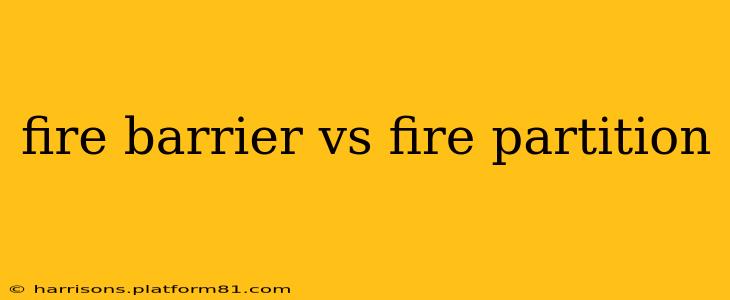Choosing the right fire protection system for your building is crucial for ensuring the safety of occupants and limiting the spread of fire. Two common components often cause confusion: fire barriers and fire partitions. While both contribute to fire safety, they have distinct characteristics and applications. This article will clarify the differences between fire barriers and fire partitions, helping you understand which is appropriate for your specific needs.
What is a Fire Barrier?
A fire barrier is a robust fire-resistant assembly designed to completely restrict the spread of fire and smoke between different sections of a building. It's a more substantial and comprehensive fire protection measure compared to a fire partition. Think of it as a significantly stronger wall—one that can withstand intense heat and flames for an extended period. This allows for compartmentalization, limiting the impact of a fire to a smaller area and providing crucial escape routes for occupants.
Key Features of a Fire Barrier:
- Complete separation: Fire barriers completely separate different areas of a building, preventing fire and smoke from penetrating.
- High fire resistance rating: They are designed to withstand intense heat and flames for a significantly longer duration compared to fire partitions, often rated for several hours.
- Structural integrity: Fire barriers maintain their structural integrity even under extreme fire conditions, providing support and preventing collapse.
- Extension through building: They typically extend from the foundation to the roof, offering continuous protection.
- Used for separating distinct areas: Fire barriers are typically used to separate different occupancy types, different parts of a building (e.g., separating a storage area from residential space), or to create fire-rated shafts.
What is a Fire Partition?
A fire partition, in contrast, offers a lesser degree of fire protection than a fire barrier. It primarily aims to limit the spread of fire within a specific area, rather than completely separating distinct areas of a building. They are often used to subdivide spaces within a larger compartment. Think of it as a more robust internal wall designed to slow the spread of fire, giving occupants more time to escape or firefighters more time to respond.
Key Features of a Fire Partition:
- Partial separation: Fire partitions don't provide complete separation but limit the spread of fire within a given space.
- Lower fire resistance rating: Their fire resistance rating is typically lower than that of a fire barrier, often measured in minutes rather than hours.
- Less demanding construction: The construction requirements for fire partitions are generally less stringent than those for fire barriers.
- Used for internal subdivisions: They are frequently used to separate different rooms or areas within a single occupancy space (e.g., separating offices in a large office space).
- May not extend through the building: Unlike fire barriers, they may not extend from the foundation to the roof.
What's the Difference Between a Fire Barrier and a Fire Partition? A Summary Table
| Feature | Fire Barrier | Fire Partition |
|---|---|---|
| Purpose | Complete separation of fire and smoke | Limit the spread of fire within an area |
| Fire Resistance | High (often hours) | Lower (often minutes) |
| Construction | More robust and stringent requirements | Less demanding requirements |
| Extent | Typically floor-to-ceiling, full-height | May not be full-height |
| Application | Separating different occupancy types, fire-rated shafts | Internal subdivisions within a space |
What are the building codes and regulations regarding fire barriers and partitions?
Building codes and regulations regarding fire barriers and fire partitions vary by location and jurisdiction. It is essential to consult your local building codes and fire safety regulations for specific requirements. These codes will outline the necessary fire resistance ratings, construction methods, and materials allowed for both fire barriers and fire partitions in different building types and occupancies. Ignoring these regulations can result in severe penalties and compromise the safety of the building’s occupants.
How do I choose between a fire barrier and a fire partition?
The choice between a fire barrier and a fire partition depends entirely on the specific requirements of your building and the intended level of fire protection. A qualified fire protection engineer or building inspector can help determine which type of fire protection system best suits your needs, taking into account the building's design, occupancy, and local regulations. This professional consultation ensures compliance with building codes and provides the optimal level of safety.
